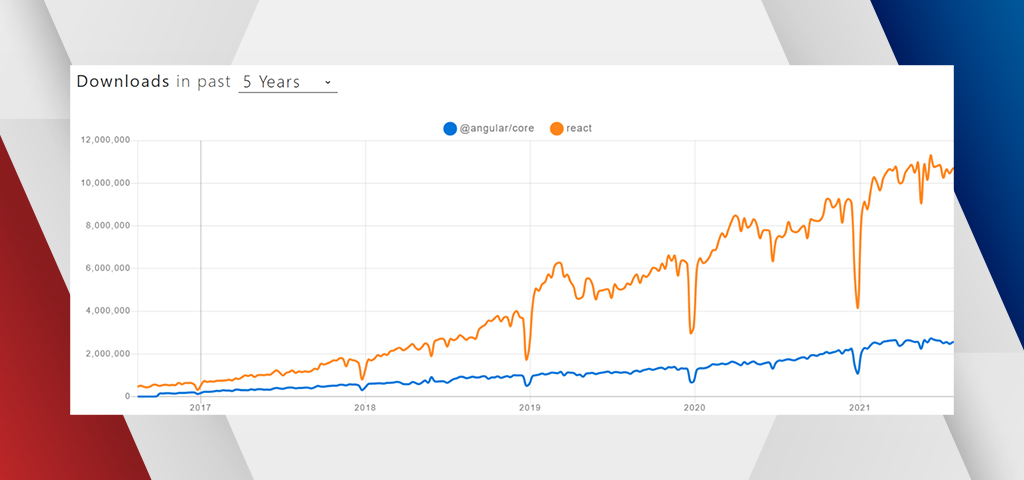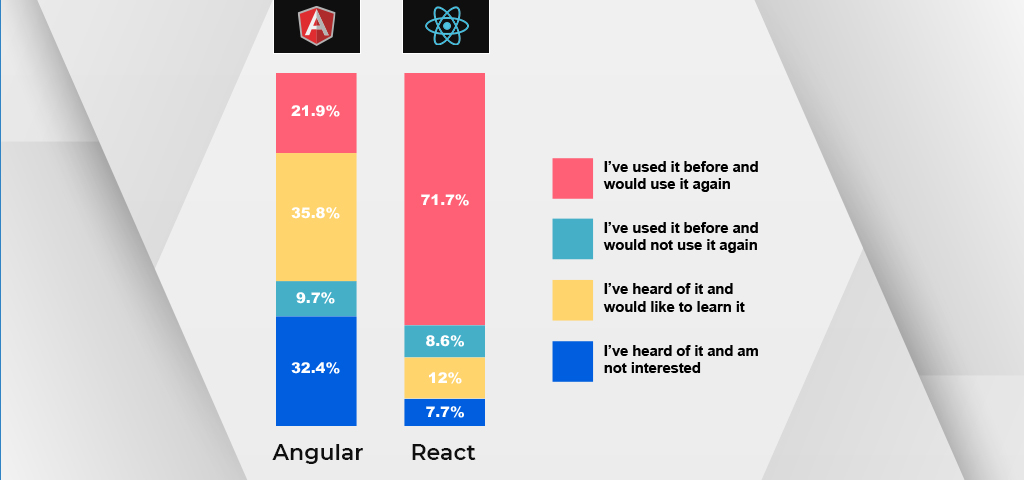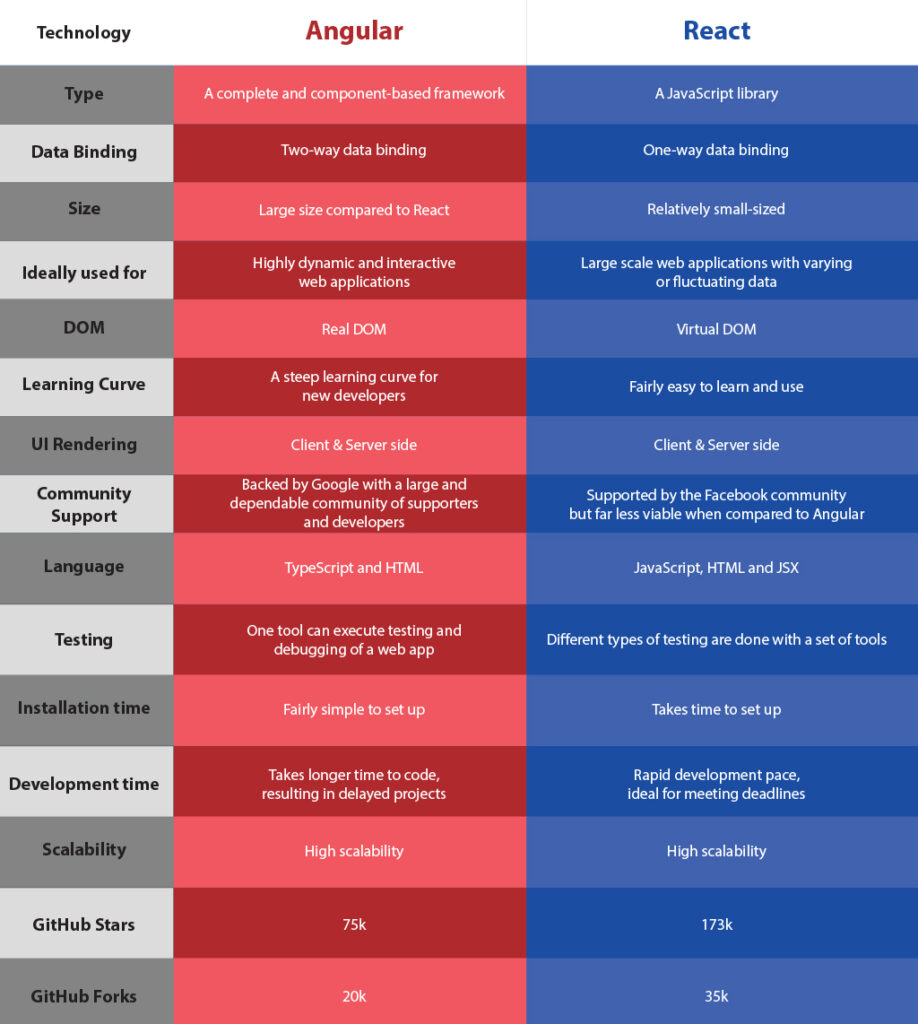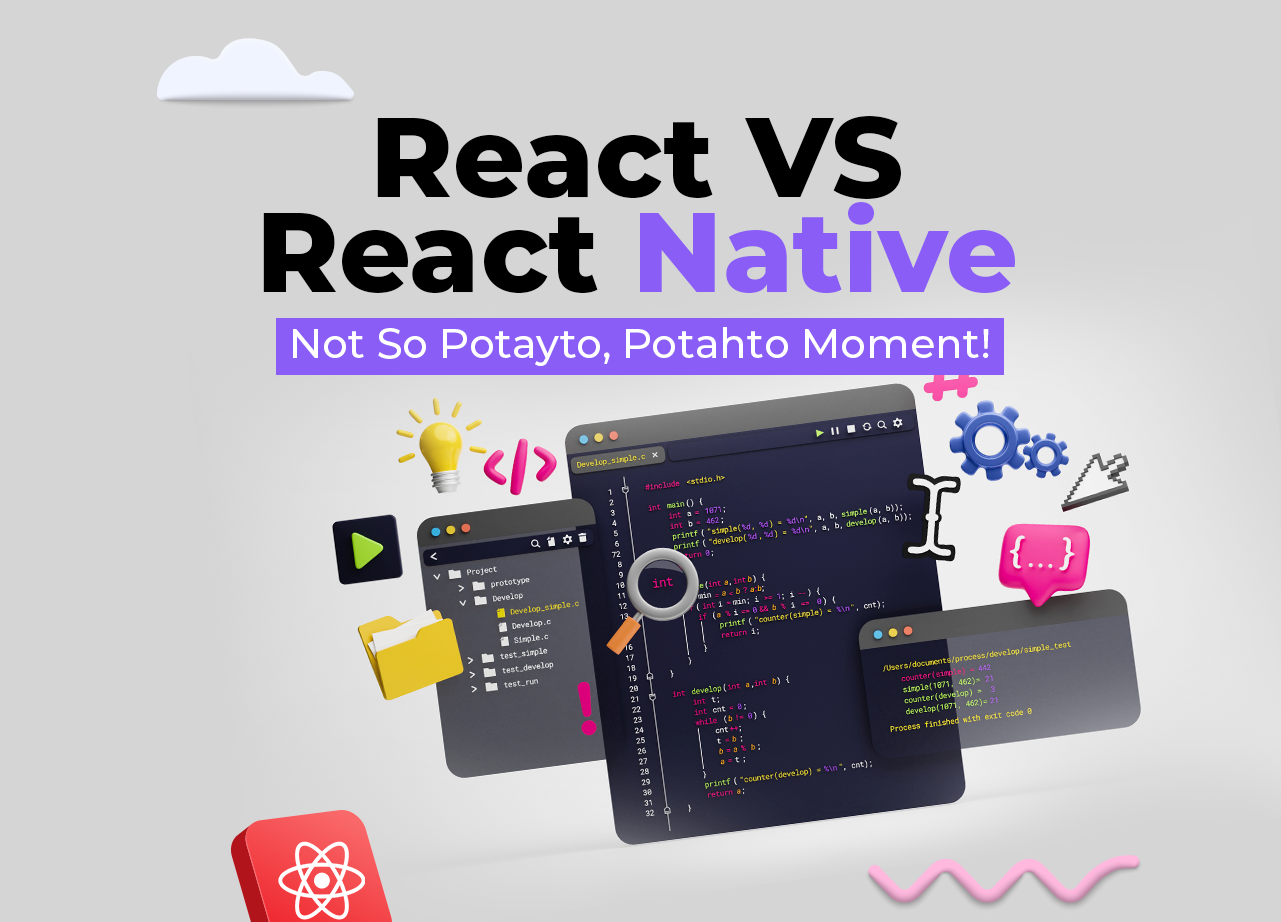The paradigm shift towards the digital age started in the early 2000s, and websites became a necessity before businesses could realise it.
With an ever-increasing global eCommerce revenue and ever-changing consumer demands, businesses have to come up with future-proof web development solutions to have an edge in the competition.
Consumers have gotten so used to impeccable online experiences that an opinion about a website is formed within half a second.
As of 2020, the web design industry has reached $40 billion already and continues to grow at an exponential rate.
With 4.45 billion internet users and 1.58 billion active websites globally, it is more than just fierce competition, it is an all-out war between businesses to attract and retain as many online customers as possible.
It is essential to get the nitty-gritty of web development correct to get the desired results. And two of the most-used and most-loved web development platforms are React and Angular. Understanding the differences and significance of these web development platforms can help you build a powerful and effective online presence.
Let’s start with some simple definitions.
Definition: React VS Angular
What is React?
React is an open-sourced JavaScript library, best known for frontend development. It is ideally used for developing UI components and user interfaces. With a “learn once and write anywhere” concept, React can be used to develop scalable and high-functioning apps for any platform. This JavaScript library provides is best for creating highly interactive user interfaces and provides performance-oriented and flexible solutions with server-side rendering. The codebase created using React is fairly simple and easy to understand and launch. Additionally, it is maintained by Google and developer communities.
Learn more about the frontend frameworks for web development in 2021.
What is Angular?
Angular is an open-sourced and TypeScript-built (a superset of JavaScript) structural development framework, best known for developing scalable and high-functioning web apps. With a plethora of tools, features and libraries like routing, client-server communication and more, Angular can be used to develop projects from single-page web apps to enterprise-grade applications. Along with a two-way data binding, Angular is supported and updated constantly by Google.
Popularity: React VS Angular
Stack Overflow and Google Trends:
We are using the data from Stack Overflow and Google Trends to measure the sheer popularity in terms of which one was most asked about or talked about between Angular VS React. This data does not represent the usage between these two development platforms.
Let’s have a look:
Google Trends:

Angular and ReactJS have both witnessed a steep rise in popularity since their inception in 2013 and 2016 respectively. Both of these platforms are highly sought after when it comes to web development. However, Angular experienced a drop in its popularity after 2018, while React maintained its prominence over the years. React has always been consistently in demand for developers around the globe, making it a universal solution for web development.

The above-mentioned survey by Stack Overflow sheds more light on the subject of popularity between Angular VS React among web developers. With more than 70% of developers choosing to stay with React accentuates the fact that it is the most sought after open-sourced JavaScript library. Nevertheless, Angular shows great potential with more than 35% of developers expressing keen interest to learn this web framework and almost 30% of developers choosing to continue working with it.
NPM Downloads and SimilarTech:
Let’s dive deeper to understand the usage comparison between Angular VS React. The data from NPM downloads and SimilarTech provides insights that will help us determine which web development platform is most used among developers around the globe.
Let’s examine:


React is used by almost 1.2 million websites and 420k unique domains, while Angular is used by almost 400k websites and 200k unique domains.
Evidently, React wins in the category of usage as well. Even though Angular shows a gradual rise and consistent demand in terms of NPM downloads, React still leads by leaps and bounds in NPM downloads and every category of websites displayed by SimilarTech.
Maturity: React VS Angular
There’s a reason why developers don’t adopt newly developed platforms, an immature web development framework would not possess the required community support or tools to reach its true potential. The maturity of a web development platform determines the quality and size of its community, as well as the efficiency of its tools and updated features.
That’s why developers always choose the platform that has been time-tested and proven its efficiency and effectiveness over the years.
The maturity of a web development platform can be judged by observing data from GitHub:
| Platform | GitHub Stars | GitHub Forks |
|---|---|---|
| React | 173k | 35k |
| Angular | 75k | 20k |
This proves that both Angular and ReactJS are well-matured web development platforms. With vast community support and adequate tools, it is quite easy to resolve issues while working with Angular and ReactJS.
Problems and bugs are quickly identified and eradicated with constant updates and newer versions, Angular is at its 12th version and React will be launching its 18th version soon enough.
Angular VS React pros and cons can reveal a lot about Angular VS React difference, let’s examine further.
Advantages: React VS Angular
Being the best options for web development, the benefits of Angular and React are endless, and we’ll discuss the most notable ones.
First, let’s understand why use React.
Benefits of React:
- Being a completely JavaScript-based web development platform, React is fairly easy to learn and use as JavaScript is the most-used programming language around the world.
- The tree-like structure of a codebase of HTML is known as the Direct Object Model (DOM). React uses a virtual DOM to specifically modify or manipulate sections of the real DOM when a change is made by the user on the frontend. This feature enables faster and smoother performance.
- Reusability of codes eases the work of the web developers by reducing the lines of code required and providing easily maintainable web UIs and web applications.
- A one-way data binding structure that simplifies the workflow and provides a downward data flow that is quite straightforward and easy to track.
- Various React developer handy tools are present to track and modify the current state and props of different components in the hierarchy of the virtual DOM.
- Unlike other JavaScript frameworks, React can be navigated easily on different SERPs, making it SEO-friendly.
- Very easy to test and debug web applications built with ReactJS.
Benefits of Angular:
- A Model-View-Controller (MVC) architecture to reduce development time by synchronizing the data in the View and the Model, eliminating the need for writing extra lines of code.
- Angular based UI uses a two-way data binding structure to improve the communication between components in the web application. The database gets constantly and simultaneously updated when a change is made in the user interface.
- Angular JavaScript developers can create efficient HTML content using Directives to assign different behaviours to different components of the Direct Object Model (DOM).
- Angular developers have complete freedom to develop and design however they want with maximum flexibility as the elements and modules of Angular are completely customizable.
- Backed by Google, Angular provides efficient community support with sufficient adequate extensions and third-party tools to aid Angular developers.
- Angular architecture is developed in a unique way that helps developers to identify and build the codebase easily.
- TypeScript language in Angular helps the developers to create clean lines of code, making it easy to identify and eradicate mistakes.
Angular VS React pros and cons are incomplete till we discuss the disadvantages.
So let’s dive in, shall we?
Disadvantages: React VS Angular
Choosing between Angular or React has always been a difficult choice, but knowing the disadvantages can simplify it. These drawbacks can lead to a well-informed decision according to your web development needs.
Let’s start with React.
Drawbacks of React:
- With a rapid development pace, React releases new updates frequently which creates an ever-changing environment. React developers have to constantly keep up with the changes and learn new ways and skills to successfully execute React web development.
- Constant updates and changes lead to insufficient documentation, forcing the developers to use poorly updated extension libraries by the supporting community.
- JSX syntax enables a combination of JavaScript and HTML. Even though this comes as a blessing for some developers, it is perceived as a barrier for new developers because of its complexity.
- Integration with MVC structured frameworks needs a complex configuration that can’t be executed without in-depth knowledge, a steep hurdle for novice developers.
Drawbacks of Angular:
- With a steep learning curve, Angular is quite difficult to learn for new developers because of the complex coding languages, customizations and integrations.
- Unlike React and Vue, Angular is a heavy-weight framework that increases its complications.
- Angular has limited SEO options, making it difficult to identify by search engine crawlers.
- The Command-line Interface (CLI) is very important to Angular developers, yet CLI documentation lacks details and developers have to put in extra time and effort to get answers to platforms like GitHub.
Use Cases: React VS Angular
No comparison is complete before discussing the use cases. The choice between Angular or React is clouded with confusion because most developers don’t understand or recognise the specific uses of these web development platforms.
Knowing “when to use” is the most significant step for successful web development.
When and Why Use React:
React can be efficiently used to handle an application’s view layer and develop reusable UI components. The most primary reason for choosing React is its ability to change, modify and load data without the need to refresh a web page.
React has Redux-like state containers for the rapid development of scalable web apps with dynamic and interactive elements.
React can be used for:
- Single page or cross-platform web app development
- Social networking websites
- Data visualization websites and tools
- Retail or eCommerce websites
- Real-time messaging web apps
- Personal or professional blogs
- A web app with multiple events
- Personalized web app solutions
- A web app project with shareable components in the DOM
5 Big names that use React:
- Netflix
- Airbnb
- Uber
When and Why use Angular:
Angular can provide rapid frontend development and it can be used as a one-stop solution for quickly developing data-intensive web applications. Angular is efficient for maintaining high-functioning and robust web applications with a reduced JavaScript codebase.
This frontend framework boosts overall performance and provides fast-paced server-side rendering.
Angular can be used for:
- Higher productivity and ready-to-use solutions
- Web apps with low to medium complexity level
- Development teams with expertise over Java, C# and different versions of Angular
- Interactive and dynamic single-page websites
- Progressive Web Applications (PWA)
- Large scale or enterprise-grade feature-rich web applications
- Websites with customizable content
- Maximise engagement in user experience in existing websites
- Update designs of old websites or web applications
5 Big names that use Angular:
- Gmail
- Santander
- Microsoft Office
- PayPal
- Forbes
Angular VS React Difference:

Final Thoughts
We understand it would make it much simpler if we had a clear winner, but that’s never the case in web development. You need to identify your web development needs to carefully determine the technology that can effectively support it.
React has been leading consistently when it comes to sheer popularity and usage but the potential and efficiency of Angular is well-known and sought after by developers everywhere.
Angular can be best used for building and maintaining highly dynamic and interactive web applications, while React is great for large-scale web applications with frequently fluctuating data.
Both Angular and ReactJS are best at what they do, and yet they’re so different. Understanding these subtle and major differences can lead to successful web development that yields effective results.
Are you looking for web development solutions to enhance your business’s online presence? We’re here to help!
With a never-say-die attitude and 16+ years of experience, Communication Crafts offers high skilled ReactJS and Angular developers to help your business flourish and prosper with ease.
Our web development services can provide websites and web applications that can captivate your existing audience and entice potential ones.
We welcome you to exploit our expertise.
Looking for bespoke web development solutions?
You demand, we deliver!
 Blog Communication Crafts
Blog Communication Crafts





